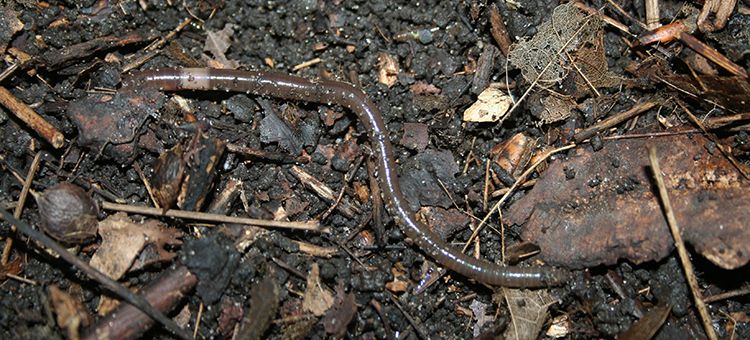Earthworms Vs Jumping Worms

Earthworms vs jumping worms
Jumping worms are a type of earthworm. They are called “jumping worms” because of their unusual behavior when disturbed – they move like a snake and sometimes appear to be jumping. A light-colored ring extends around the body and is closer to the head than in other earthworms.
What is the difference between nightcrawlers and jumping worms?
Jumping worms are darker in color with comparatively rigid bodies when compared to European worms, such as nightcrawlers. A jumping worm's clitellum (a distinctive band on most earthworms' bodies) is relatively closer to its head, smooth to its body, and completely encircles the animal.
Are jumping worms harmful?
These invasive worms can severely damage the roots of plants in nurseries, gardens, forests, and turf. They, along with other invasive worms, can also help spread invasive plant species by disturbing the soil.
How are jumping worms different from European worms?
European species have a saddle shaped clitellum that swells up and does not wrap around the entire body. Jumping worms have an annular clitellum that is less swollen, and it wraps around the entire body.
Can you touch jumping worms?
Around their body close to the head. And it stands out from the rest of their body which is sort of
What do you do if you find jumping worms?
To kill adult jumping worms, handpick them from the soil, place them in a plastic bag in the sun, then throw them in the trash. A mustard solution can irritate the jumping worms and help bring them to the surface for picking.
What temperature kills jumping worms?
Summary: New research shows that temperatures of about 100 degrees Fahrenheit kill the cocoons of invasive jumping worms. That's good news for ecologists and horticulturalists who are working to slow or stop the spread of the worms, which can damage the soils they invade.
Why not use jumping worms for bait?
Jumping worms transform soil structure and chemistry in ways that are harmful to many common garden plants, especially those with shallow or fine-haired root systems such as strawberries. Soil invaded by jumping worms tends to be drier and less nutrient-rich.
Why do birds not eat jumping worms?
Jumping worms are very small when birds migrate. The worms tend to be active from mid-May to November, and are not likely to be much of a food resource for birds during migration. However ground-foraging birds like thrushes, including robins, commonly consume earthworms present at the soil surface.
Are jumping worms good for the soil?
Jumping worms turn rich organic soil into small crumbles that resemble coffee grounds. This depletes nutrients, disturbs the soil fungi and decreases the water-holding ability of soils. All this impacts the health and productivity of our garden plants.
Are jumping worms good for garden?
Jumping worms are a major problem for gardeners and potentially farmers because they live in the top few inches of soil and vigorously consume many types of organic matter in that top soil horizon, including plant roots.
How do you tell if a worm is a jumping worm?
What jumping worms look like
- Smooth, glossy dark gray/brown color.
- Clitellum*, the lighter-colored band, is cloudy-white to gray; completely encircles the body. Its surface is flush with the rest of the body.
- Snake-like movement.
- They tend to occur in large numbers; where there's one, there are always more.
Does anything eat jumping worms?
Salamanders and many bird species will not eat jumping worms, spitting them out or avoiding them after an initial tasting. Ground-nesting birds disappear. However, moles will eat them, so can be helpful in controlling them.
Can jumping worms bite?
Unlike snakes, a jumping worm cannot inject venom into your flesh, nor does it bite larger creatures in the way that even nonpoisonous snakes do.
Do jumping worms come out at night?
“Night-crawlers, as their name states, are not typically seen above ground during the day, venturing out at night in moist grass. Sometimes one gets in over its head and drowns in a puddle; worms need to come up for air, which is why when it rains, they clear their tunnel by emerging from the ground during rains.
What states are jumping worms found in?
What states are jumping worms in?
- Alabama.
- Connecticut.
- Florida.
- Georgia.
- Kentucky.
- Louisiana.
- Maine.
- Maryland.
How long do jumping worms live?
Jumping worms don't need a mate to reproduce, therefore, one jumping worm can start a new population. They have a lifespan of one year, with adults maturing in June and producing egg cocoons from later summer into early fall. Adults dies in late fall and the cocoons survive over winter and hatch in spring.
What does soil look like after jumping worms?
Jumping worms live in the leaf litter and the top few inches of soil on the forest floor. They change the soil texture to appear like coffee grounds, strip the soil of nutrients and can kill plants. Prevention is the only known way to manage them. Jumping worms should be disposed of in the garbage.
How did jumping worms get in my garden?
Any earthworms present there — including the common night crawler — are of European origin, presumably brought over by settlers as part of ship ballast material or in soil around plant roots. Asian earthworms were first identified in the United States in the 1870s, in California, Dr.
What is the mustard test for jumping worms?
Mix a gallon of water with 1/3 cup of ground yellow mustard seed and pour slowly into the soil. This will drive any worms to the surface. If you have jumping worms, report it and avoid moving plants or soil from your yard.











Post a Comment for "Earthworms Vs Jumping Worms "